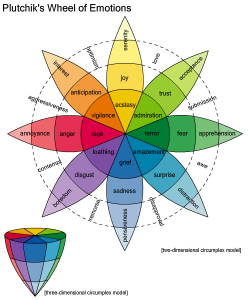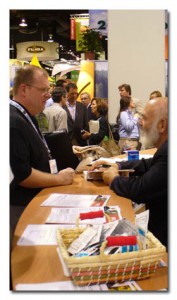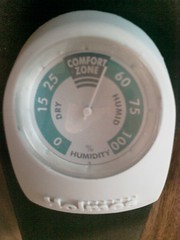Your Emotions On the Tradeshow Floor
Just like the sales situation of a tradeshow floor is magnified by the intensity and chaos of the situation, so are the emotions of exhibitors and attendees.
If you’ve been to a lot of tradeshows like I have, and you pay attention to how people are (and take a few moments to talk one-on-on with them), you realize that people are holding emotions in. Not all of them, of course. We are human and those emotions come out. But many are buzzed, giddy, exhausted and likely stressed out to the max. Or not.
Constant interaction with people pushes stress higher. Standing on your feet all day makes you tired and exhausted, giving way to heightened emotions.

In 1980 Robert Plutchik created the Wheel of Emotion (at left), showing eight basic emotions and eight advanced emotions each composed of two basic ones.
The basic emotions: Joy, Trust, Fear, Surprise, Sadness, Distrust, Anger and Anticipation.
The advanced emotions are Optimism (Anticipation and Joy), Love (Joy and Trust), Submission (Trust and Fear), Awe (Fear and Surprise), Disappointment (Surprise and Sadness), Remorse (Sadness and Disgust), Contempt (Disgust and Anger), and Aggressiveness (Anger and Anticipation).
No matter what emotions you feel while attending or working a tradeshow, it’s easy to get caught up. Have you ever felt yourself feeling heightened instances of Joy, Anger, Anticipation or Sadness?
You feel JOY when you make a big sale. You feel ANGER or DISAPPOINTMENT when you’re told you have to work an extra two hours after having already spent the day on your feet. You may feel REMORSE when you said the wrong thing to a potential client or let slip some inside information to a competitor.
And you could be feeling more AGGRESSIVE than you might normally in the OPTIMISM of heading into a show where you want to knock ’em dead with a great presentation, a great booth and a terrific product backed up by a great marketing effort.
Other researchers have pointed to other emotions such as Doubt, Envy, Frustration, Guilt, Shame; Boredom, Despair, Disappointment, Hurt, Shock, Agitation, Amusement, Delight, Elation, Excitement, Affection, Empathy, Friendliness and Love.
Part of the challenge of attending tradeshows is to know that the intense activity of the tradeshow floor, the after-hours parties, break-out sessions or client meetings is to be expected: mentally prepare for them, and plan on some ‘down time’ in your hotel room before hitting your pillow.
If you’re prepared for the heightened emotions, you’ll be able to take them more in stride.
But of course…you gotta be YOU! And if that means getting carried away by the situation, so be it.
What does a tradeshow do to your emotions? Does it put you on a roller-coaster or do you take it all in and enjoy it for what it is?
graphic copyright Ivan Akira – used under Creative Commons usage guidelines











